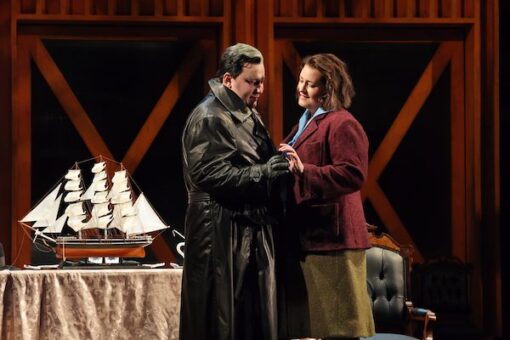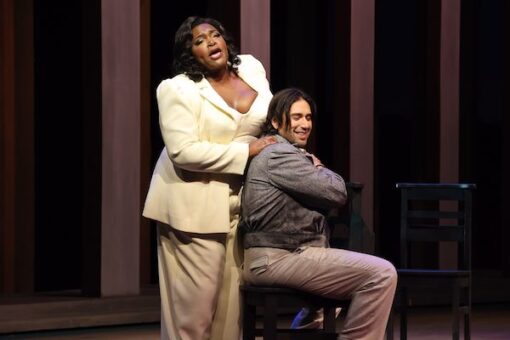Dubious “Dutchman” and trenchant “Tosca” refract two classics through modern lenses at Santa Fe Opera

General director Robert Meya has given Wagner fans cause to rejoice: Santa Fe Opera went from no Wagner in over three decades to presenting his operas in two consecutive seasons. Of the whole Wagner canon, The Flying Dutchman may turn off audiences the least. Before last year’s Tristan, it was the only Wagner ever mounted at Santa Fe, last seen in 1988. Alas, this baffling new production, seen Monday night, is much better heard than seen.
The captain of the ghost ship named The Flying Dutchman is cursed to wander the seas for eternity, unless he can find a bride who loves him faithfully. During a storm off Norway, he meets another captain, Daland, who is swayed by the riches offered to give the doomed man his daughter Senta in marriage. Although the demonic nature of the ship and its captain quickly become apparent to all, Senta sacrifices herself to save him.
Nicholas Brownlee, an apprentice singer here in 2014 and 2015, caused a sensation as Kurwenal in Tristan last summer. The strength of the Alabama-born bass-baritone’s performance drew not only on rafter-shaking intensity, up to the heights of his range, but on musical consistency and characterization created through careful diction and phrasing. It was a shame that he was not featured in a staging that reinforced the character’s supernatural power.
South African soprano Elza van den Heever, a Santa Fe favorite for many years, sang her first Senta earlier this year at the Metropolitan Opera. With true intonation, she paced her silky rendition of the Act II Ballad with delectable phrasing, and her high Bs at the big climaxes rang out clearly. It was only that last bit of incandescent wattage that lacked, partly because she was up against such a booming Dutchman.
Bass Morris Robinson matched Brownlee in stentorian resonance as Daland, treating the role of Senta’s money-hungry father with humor. Chad Shelton, a Texas-born tenor, made a surprise company debut as Erik, replacing Richard Trey Smagur in the middle of rehearsals. Everyone, including Erik, knows that the tenor is supposed to end up with the soprano, and Shelton deployed his pleading voice to that end, up to a solid B-flat in his final Cavatina.
Another former apprentice, tenor Bille Bruley, gave a youthful brightness to the role of the Steersman. His love song in the first act, during which he falls asleep on the watch, is partly unaccompanied, leaving just the beauty of the voice to be enjoyed. Mezzo-soprano Gretchen Krupp, a current apprentice singer hailing from Woodbridge, Virginia, gave a sharp edge to the role of Mary.
The real star of the production was the troupe of apprentice singers, who gave the finest interpretation of the opera’s choral scenes possible, well drilled by veteran chorus master Susanne Sheston.
At the podium was young German conductor Thomas Guggeis. His interpretation was heavy on potent full-orchestra sound, and the orchestra, especially the brass, were in fine form. Even Wagner, however, has subtleties, over which Guggeis tended to ride roughshod.
David Alden once again imposed a peculiar vision on his first staging of the work. The confrontational director has said that he sees the Dutchman as an industrialist turning the world into a capitalist machine with his overseas profiteering, “like a nightmare of Elon Musk.” His Dutchman entered in the first act wearing an executive’s business suit (costumes by Constance Hoffmann), took a seat at a large desk, and rolled around absurdly in a desk chair.
The ghost ship’s crew became faceless corporate drones, played by robot-like supernumeraries. Even the women of the village, rather than spinning, worked in some sort of factory, costumed like yellow Minions (from the movie Despicable Me) and moving in ridiculous dance movements (choreography by Maxine Braham). The director’s political interference dulled the menace of the Dutchman and his zombie crew. It also robbed Senta’s sacrifice of its beauty, as she was left tangled in ropes, the staging oblivious to the apotheosis audible in the score’s final bars.

The Crosby Theater was most full this week on Tuesday night, for this year’s production of Giacomo Puccini’s Tosca. Always an audience favorite, last staged here in 2012, it comes with an excellent cast and, thanks to conductor John Fiore, sensitive and luxuriant musical pacing. As usual for Santa Fe Opera’s stagings of crowd-pleasers, the production provides a surprising twist, fortunately not as off-putting as last year’s take on Carmen.
Philadelphia-born soprano Leah Hawkins, familiar from her apprentice years at Washington National Opera and her work at the Metropolitan Opera, leaned into the drama queen side of the title role. The former mezzo-soprano’s coffee-rich vocal tone gave the performance considerable heft, but she was able to sweeten her sound and add pleasing variety as well. Her show-stopping “Vissi d’arte” was a moment to savor. (Angel Blue, scheduled to sing the role in the middle of the run, withdrew because of a family emergency last month.)
Joshua Guerrero’s bravura sound gave a suitably heroic edge to the role of Cavaradossi, Tosca’s lover. His high notes rang out with impressive squillo throughout the evening, prompting some excited cheers and applause, even at inappropriate moments. His Italianate sobbing tone made the Act III prison scene (“E lucevan le stelle”) a highlight, even more poignant in that this was the young Californian’s last performance of the run.
Rounding out the excellent lead casting was Reginald Smith, Jr. as Scarpia. From the moment of his grand entrance, walking on chairs so that he towered over the stage, Smith’s imperious voice blustered and sneered. His rendition of the finale to Act I amid the chorus’s impassioned “Te deum” impressed by its poisonous villainy, with the blasphemy of the sentiments emphasized by Scarpia’s presence in the midst of the religious ceremony.
Baritone Blake Denson made a clearer and more favorable debut as a stalwart Angelotti than his amplified Plutone in Orfeo. Santa Fe Opera veteran Dale Travis offered comic relief as the hypocritical Sacristan, at one point wielding an out-of-control floor polisher. Young treble Kai Edgar returned to sing the wistful cameo of the Shepherd at the start of Act III.
At the podium John Fiore led the orchestra in a performance that was at times explosive, sometimes affecting balances with the stage, but ruminative at others, with plenty of room for the singers to take their time. The moody playing of the four cellos and three clarinets, in the gloomy introduction to the Act III prison scene, proved another highlight, as was the crisply coordinated off-stage cantata in Act II.
Keith Warner, in his Santa Fe Opera debut, made the shepherd’s appearance, so often a throwaway, into one of the high points of his thoughtful staging. The English director had Cavaradossi enter early for the prison scene, so that he was on stage to hear the ringing of distant sheep bells. Warner recast this moment as a vivid pre-execution memory, with the boy as the young Cavaradossi, singing and making drawings in a sketchbook that he carried.
Although Cavaradossi’s life as a painter is often forgotten in the opera after Act I, the shepherd scene provided a tie-in to Warner’s updating of the story to the mid-20th century. The sets, designed along with costumes by Ashley Martin-Davis, evoked the neoclassical architecture, looming shadows, and paranoid empty cityscapes of metaphysical painter Giorgio De Chirico. According to Robert Meya, the Italian artist worked at Santa Fe Opera late in life in 1971, leaving behind a few watercolors in their collection.
The scene painted at the back of the stage in Act III recalled De Chirico’s series of lithographs illustrating the Apocalypse, made during the fearful years of World War II. The specters of religious authoritarianism and torture by Scarpia’s secret police made sense in the context of Mussolini’s fascist Italy. Caught for garroting Scarpia, rather than stabbing him, Tosca shot herself rather than leaping from the parapet of the Castel Sant’Angelo, while a parallel version of her walked through De Chirico’s image of the pale rider of Death.
The Flying Dutchman runs through August 25, with Alden Gatt conducting the final performance. Tosca runs through August 26, with Freddie De Tommaso taking over as Cavaradossi in his American debut. santafeopera.org